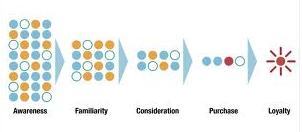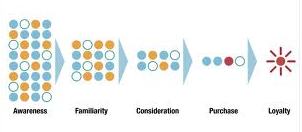In our previous blog, we had talked of the Customer Decision Journey. As a marketer, having a good grasp of this buying cycle is not only important but also a foregone conclusion. Taking a step forward, let us understand the importance of communication process to your prospective customers.
Why does communication play a vital role?
How does it matter having a structured communication strategy?
Let’s understand it with the help of the very simple diagram by McKinsey.
As part of the customer buying process, 4 broad phases can be mapped out.
As seen, loyalty forms the termination phase, but for simplicity let’s assume the fact it’s a ‘first time purchase’ for a customer.

- Awareness – (Pre-launch period & immediate period after launch)
It encompasses all the pre-launch, teaser, branding and also launch-related activities. Considering a movie as an example, the trailer, music videos, press releases are all part of the awareness phase. Higher the audience awareness, higher is the reach and better the chances that the audience translates into ticket sales. In digital marketing lingo, ‘impressions’ is the right word for spreading awareness. Hence, media planning and buying on various high traffic sites is the right strategy in terms of making the target group aware about the product.
The communication should thus highlight the USP’s of the product. The brand presence on all major media sources is important. PR activities form the core part of this phase. Generic communication to a variety of audience is the right strategy to catch the eye of prospects.
- Familiarity – (Few days after launch period)
Awareness campaigns generate leads. These leads are the ones which have shown interest in the product. They see the product as fulfilling one of their needs. Such leads are curious to know more about the product. A general information or communication will not be sufficient to sustain their attention span. More focussed messages about the product is the right path forward. Lead nurturing strategies works well in this stage. Once prospects/visitors are familiar with some of the features/aspects of your product, more information and also new information needs to be shared with them. This is done till the lead shows favourable responses to your communication.
Ex – The lead watches the trailer of the movie on YouTube, clicks on the link to the website, downloads some music, fills outs some polls/surveys. This shows that the lead has shown considerable interest in the product (movie). Getting this information is vital for a company in order to build up a customer behaviour map. Engaging the customer through different modes and touch points helps nurture the customer towards making a decision of making a purchase.
Basically, sustaining the interest in the leads by follow-ups, reminders till some of them advance to the consideration phase will be our goal here.
- Consideration – (After a lead becomes warm)
Interested leads are given preference in the sales communications. The communication is much more focussed in this phase. Comparisons of the product with similar category products, advantages, cost savings, investment return period, or efficiency of the service are the kind of pitch points utilized. Leads in this phase regularly consume new content about a product/service and thus consistently interact with the brand. The brand messages must therefore be such that the lead remains engaged with the brand. Appropriate marketing messages to cater to the higher level of needs must be taken into account. Many times, highly trained/experienced sales personnel takes control in keeping contact with the lead and see to it that the lead stays warm or turns into a hot lead.
- Purchase – (Hot leads)
This is when a customer is about to make a purchase. This stage is very critical as a single bad experience can change the opinion of the lead. A very subtle approach in handling lead queries should be taken. Communication pointers involve booking dynamics, financial issues and any particular or queer requests of the leads. Adaptability of the sales personnel to varying customer needs is vital. With experience, the sales team is able to identify the pain points in their product/service wherein a lead may drop off. A communication with a voice of assurance is what will score the deal. Experiences of a customer at this critical juncture may ultimately define the lead closures.
- Loyalty – (After purchase & thereafter)
Loyalty period involves keeping the customer regularly updated with important events, offerings. Customers can be enticed to refer to their network and earn rewards to continue interactions with the brand. Community building measures help in defining this phase. An exclusive membership to select buyer’s club, preferential treatment for existing customers, special invitations, etc are some of the activities that help in maintaining a feeling of loyalty for customers.
Our next blog will focus more on lead nurturing strategies and cycles. We will be using some industry-level examples to understand this very important activity in lead management and customer purchase journey.
Credits –
Atul Jethmalani Ketan Sabnis
